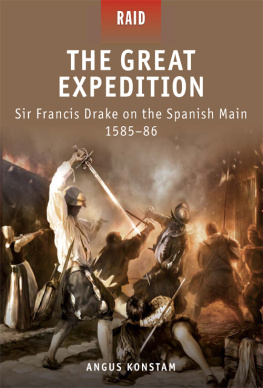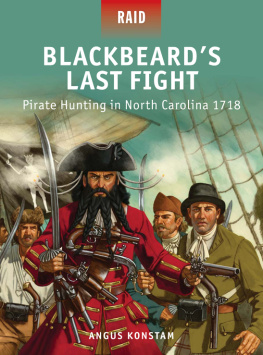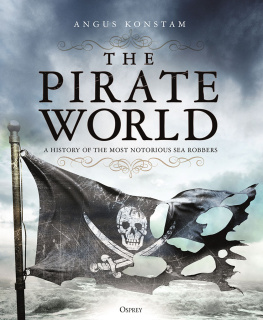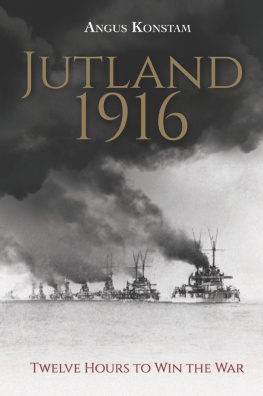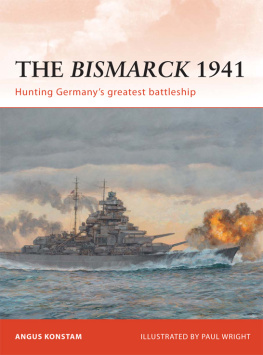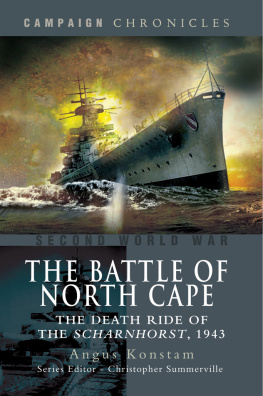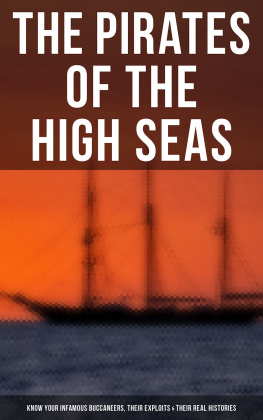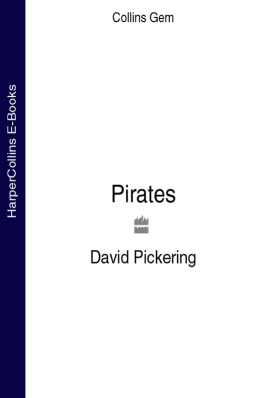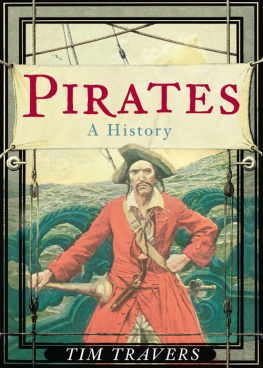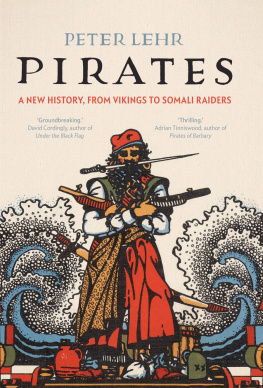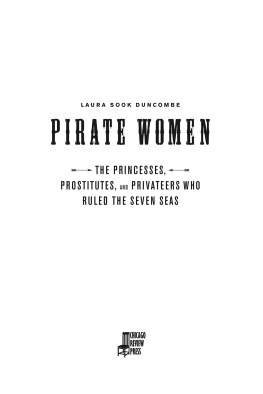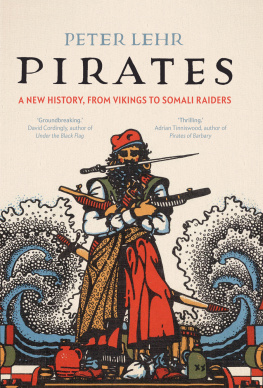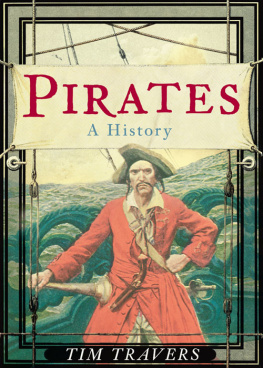PIRATES
ALSO BY ANGUS KONSTAM
Ghost Ships: Tales of Abandoned, Doomed, and Haunted Vessels
The History of Shipwrecks
World Atlas of Pirates: Treasures and Treachery on the Seven Seas in Maps, Tall Tales, and Pictures
Copyright 2008 by Angus Konstam
ALL RIGHTS RESERVED. No part of this book may be reproduced or transmitted in any form by any means, electronic or mechanical, including photocopying and recording, or by any information storage and retrieval system, except as may be expressly permitted in writing from the publisher. Requests for permission should be addressed to Globe Pequot Press, Attn: Rights and Permissions Department, P.O. Box 480, Guilford CT 06437.
First published in the UK in 2008 by Osprey Publishing
First Lyons Press paperback edition 2011
Lyons Press is an imprint of Globe Pequot Press.
Designed by Ken Vail Graphic Design
Maps by Peter Bull Art Studio
Black-and-white images courtesy of Stratford Archive
Library of Congress Cataloging-in-Publication Data is available on file.
ISBN 978-0-7627-7395-4
Printed in the United States of America
10 9 8 7 6 5 4 3 2 1
INTRODUCTION
I t is hardly surprising that the main contenders for the title of the worlds oldest professionprostitution, law, and journalismall share a common bond. They all tend to operate on the margins of acceptable society, making money from, or producing stories about, an underworld of crime, corruption, and sleaze. I am probably being a little harsh on prostitutes and journalists, but the point is that crime, and public fascination with it, is as old as civilization itself. It is therefore not unexpected that in 1724, when a London publisher began selling a new book called A General History of the Robberies and Murders of the Most Notorious Pyrates, this lurid expos of a world of crime proved to be a runaway success. It lifted the lid on activities that most of its readers had never dreamed of. It told of violent criminals operating on the high seas and of men (and a few women) who rebelled against the constraints of early eighteenth-century society and who lived by their own piratical code. Of course it also helped that these tales were set against a backdrop of exotic tropical locations and that most pirates met a colorfully violent end. Almost three centuries later this fascination still exists.
The term pirate instantly conjures up a picture of a figure in a battered coat and tricorne hat, festooned with weaponry and seeming as if he could fillet you with his cutlass as soon as look at you. Of course we owe most of this to Hollywood and to the piratical images first evoked by Robert Louis Stevenson in Treasure Island. Johnny Depp took this classic pirate image in the Pirates of the Caribbean films and made it his own, and, like the other pirates of book, stage, and silver screen, Captain Jack Sparrow became a wonderful blend of pirate fact and pirate fiction. Pirates are used to sell everything from rum to cars, from homes to insurance. Like the pirate himself, the skull and crossbones symbol used on pirate flags has become an instantly recognizable and identifiable image a symbol of piracy and of rebellion against authority.
In a way all this began with Captain Charles Johnson, the man who wrote that bestseller back in 1724. His descriptions of pirates such as Blackbeard and Black Bart Roberts, of Calico Jack Rackam and Charles Vane, were augmented by a series of engravings that set the standard for the centuries of pirate imagery that followed it. These days, pirates are portrayed either as figures of fun or as romantic characters, rather than as the seafaring criminals they really were. The very phrase the golden age of piracy was coined by the creators of pirate fiction rather than by the people who experienced piracy for themselves. There was nothing golden or romantic about being the prisoner of some of these famous piratesalthough the gentle readers of Captain Johnsons pirate biography would have felt safe enough in their own homes to cast the pirates he wrote about in their own romanticized light. This process simply continued, so that nowadays Jack Sparrow, Captain Hook, Long John Silver, and Captain Blood are but pale and harmless imitations of the real thing.
This book tells the story of the real pirates of historythe men for whom shipwreck, starvation, disease, and violent death were a constant threat, and whose piratical careers were usually measured in months rather than in years. While these pirates certainly did operate in exotic locations such as the Caribbean, and their story occasionally involves marooning, buried treasure, desert islands, and parrots, the notion that their lives were in any way romantic would have been highly amusing to them. The aim of this book is to allow people to unravel the popular pirate image of today from the far less appealing reality of these historical figures.
Even the term pirate has been changed over the years. Scriptwriters who should know better manage to confuse the name with others, such as privateer, buccaneer, filibuster, corsair, freebooter, and swashbuckler. Well examine these terms throughout the book, but, briefly, all of them have their own separate meanings. A privateer was a man or a ship under contract to a government, allowing it to attack enemy ships during wartime. This contract, called a letter of marque, meant that the government got a share of the profits. In effect the privateer was a licensed pirate who did not attack his own people. The French called these people corsairs, although the term later became associated with Mediterranean pirates rather than just privateers.
In the seventeenth century the term buccaneer referred to the English, Dutch, or French raiders who preyed on the Spanish, attacking cities as well as ships on the high seas. A filibuster (or freebooter) was simply a French word for a buccaneer. As for swashbucklers, the term referred originally to a sixteenth-century armed brigand and later to a seventeenth-century swordsman. In the early twentieth century swashbuckler was used by writers of pirate fiction, and from there the term was adopted by Hollywood, where it is now used to refer to a particular type of movie. In the piratical heyday the term was never used the way it is today.
Finally there were the pirates. A proper pirate attacked any ship, regardless of its nationality. The dictionary specifies that a pirate is someone who robs from others at sea and who acts beyond the law. Sometimes the pirates themselves crossed the boundaries from one category into another. Captain Kidd was a privateer who later turned to piracy. Benjamin Hornigold was a pirate who attacked only Spanish and French ships, as he wanted to maintain the illusion that he was a privateer. Francis Drake was a privateer, although the Spanish did not recognize his legal status as one and simply called him a pirate. To muddy the waters even further, Henry Morgan was a buccaneer operating under a privateering letter of marque, although England and Spain were at peace when he attacked Panama, so technically he acted as a pirate.
This book aims to provide a general overview of piracy through the ages, from the Ancient Mediterranean to the present day. However, as well as covering this broad range of history, it also concentrates on the periods we now regard as the heyday of piracy in the Caribbean. These fall into two erasthat of the buccaneers who preyed on the Spanish Main in the mid-seventeenth century, and that of the era known to modern historians as the Golden Age of Piracy. This was the time when men such as Blackbeard and Black Bart Roberts sailed in search of prey. While it is important to cover the broad picture of piracy through the ages, this approach also allows us to look a little more deeply into these key periods and to tell a more detailed story about some of the most famous pirates in history.


